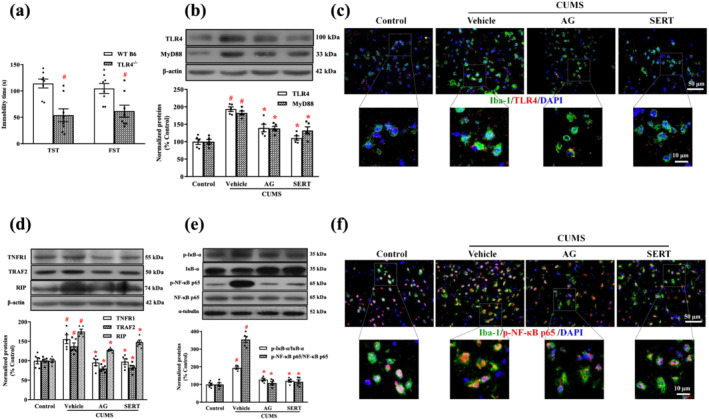FIGURE 6.

Arctigenin inhibited CUMS‐induced HMGB1/TLR4/NF‐κB or TNF‐α/TNFR1/NF‐κB signalling pathway in the PFC of mice. Arctigenin (AG;100 mg·kg−1) or sertraline (SERT; 10 mg·kg−1) was administered once daily for 6 weeks. (a) WT B6 and TLR4−/− mice were exposed to CUMS for 6 weeks, and despair behaviours in CUMS‐induced WT B6 and TLR4−/− mice were assessed with the TST and FST. The data are expressed as means ± SEM (n = 8). # P < 0.05, significantly different from WT B6 mice; Student's unpaired t test. (b) The expression of TLR4 and MyD88 was analysed by western blot. The protein levels were normalized to the level of β‐actin (n = 5). (c) Representative microscopic images showed double immunohistochemical staining for Iba‐1 (green) and TLR4 (red) in the PFC. The smaller areas in the square were shown below at higher magnification (n = 5). (d) The expression of TNFR1, TRAF2, and RIP was analysed by western blot. The protein levels were normalized to the level of β‐actin. (e) The total p‐IκB‐α and p‐NF‐κB p65 protein levels in the PFC of mice were analysed by western blot. Each immunoreactive band of the phosphorylated protein was normalized against unphosphorylated protein (n = 5). (f) Representative microscopic images showed double immunohistochemical staining for Iba‐1 (green) and p‐NF‐κB p65 (red) in the PFC. The smaller areas in the square were shown below at higher magnification (n = 5). The data are expressed as means ± SEM. # P < 0.05, significantly different from control group; *P < 0.05, significantly different from vehicle group; one‐way ANOVA followed by post hoc Tukey's test
